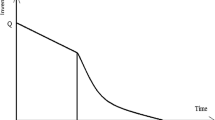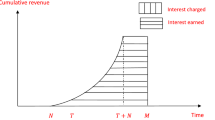Abstract
The purpose of this study is two-fold. The first is to consider supplier’s and retailer’s trade-credit policy for fixed lifetime products and the second is to extend Mahata’s 2012 model with time varying deterioration where Mahata (Expert Syst Appl 39(3):3537–3550, 2012) wrote exponential deterioration but actually he considered constant deterioration. We assume that the suppliers offer full trade-credit to retailers but retailers offer partial trade-credit to their customers. Some numerical examples along with graphical representations are given to illustrate the model.















Similar content being viewed by others
References
Abad, P. L., & Jaggi, C. K. (2003). A joint approach for setting unit price and the length of the credit period for a seller when end demand is price sensitive. International Journal of Production Research, 83(2), 115–122.
Aggarwal, S. P., & Jaggi, C. K. (1995). Ordering policies of deteriorating items under permissible delay in payments. Journal of the Operational Research Society, 46(5), 658–662.
Arcelus, F. J., Shah, N. H., & Srinivasan, G. (2003). Retailer’s pricing credit and inventory policies for deteriorating items in response to temporary price/credit incentives. International Journal of Production Economics, 81–82, 153–162.
Chang, H. J., Huang, C. H., & Dye, C. Y. (2001). An inventory model for deteriorating items with linear trend demand under the condition of permissible delay in payment. Production Planning and Control, 12(3), 274–282.
Chen, X., & Wang, A. (2012). Trade-credit contract with limited liability in the supply chain with budget constraints. Annals of Operations Research, 196(1), 153–165.
Chen, S.-C., Cárdenas-Barrón, L. E., & Teng, J. T. (2014). Retailers economic order quantity when the supplier offers conditionally permissible delay in payments link to order quantity. International Journal of Production Economics, 155, 284–291.
Chung, K. J. (2011). The simplified solution procedures for the optimal replenishment decisions under two-level of trade-credit policy depending on the order quantity in a supply chain system. Expert Systems with Applications, 38(10), 13482–13486.
Chung, K. J., & Cárdenas-Barrón, L. E. (2013). The simplified solution procedure for deteriorating items under stock-dependent demand and two-level trade-credit in the supply chain management. Applied Mathematical Modelling, 37(7), 4653–4660.
Chung, K. J., Cárdenas-Barrón, L. E., & Ting, P. S. (2014). An inventory model with non-instantaneous receipt and exponentially deteriorating items for an integrated three layer supply chain system under two levels of trade-credit. International Journal of Production Economics, 155, 310–317.
Ghare, P. M., & Schrader, G. H. (1963). A model for exponentially decaying inventory system. Journal of Industrial Engineering, 14(5), 238–243.
Goyal, S. K. (1985). Economic order quantity under conditions of permissible delay in payments. Journal of Operational Research Society, 36(4), 335–338.
Ho, C. H. (2011). The optimal integrated inventory policy with price-and-credit-linked demand under two-level trade credit. Computers and Industrial Engineering, 60(1), 117–126.
Huang, Y. F. (2006). An inventory model under two-level of trade-credit and limited storage space derived without derivatives. Applied Mathematical Modelling, 30(5), 418–436.
Khanra, S., Mandal, B., & Sarkar, B. (2013). An inventory model with time dependent demand and shortages under trade-credit policy. Economic Modelling, 35, 349–355.
Khouja, M., & Mehrez, A. (1996). Optimal inventory policy under different supplier credit policies. Journal of Manufacturing Systems, 15(5), 334–339.
Li, Y., Zhen, X., & Cai, X. (2014). Trade-credit insurance, capital constraint, and the behavior of manufacturers and banks. Annals of Operations Research. doi:10.1007/s10479-014-1602-x.
Liao, H. C., Tsai, C. H., & Su, C. T. (2000). An inventory model with deteriorating items under inflation when a delay in payment is permissible. International Journal of Production Economics, 63(2), 207–214.
Mahata, G. C. (2012). An EPQ-based inventory model for exponentially deteriorating items under retailer partial trade-credit policy in supply chain. Expert Systems with Applications, 39(3), 3537–3550.
Manna, S. K., & Chaudhuri, K. S. (2006). An EOQ model with ramp type demand rate, time dependent deterioration rate, unit production cost and shortages. European Journal of Operational Research, 171(2), 557–566.
Ouyang, L. Y., Yang, C. T., Chan, Y. L., & Cárdenas-Barrón, L. E. (2013). A comprehensive extension of the optimal replenishment decisions under two-level of trade-credit policy depending on the order quantity. Applied Mathematics and Computation, 224, 268–277.
Philip, G. C. (1974). A generalized EOQ model for items with Weibull distribution. AIIE Transactions, 6(2), 159–162.
Sana, S. S. (2008). A deterministic EOQ model with delay in payments and time varying deterioration rate. European Journal of Operational Research, 184(2), 509–533.
Sarkar, B., Sana, S. S., & Chaudhuri, K. (2010). A finite replenishment model with increasing demand under inflation. International Journal of Mathematics in Operational Research, 2(3), 347–385.
Sarkar, B. (2012a). An EOQ model with delay in payments and stock dependent demand in the presence of imperfect production. Applied Mathematics and Computation, 218(17), 8295–8308.
Sarkar, B. (2012b). An EOQ model with delay in payments and time varying deterioration rate. Mathematical and Computer Modelling, 55(3–4), 367–377.
Sarkar, B., Saren, S., & Wee, H. M. (2013). An inventory model with variable demand, component cost and selling price for deteriorating items. Economic Modelling, 30, 306–310.
Sarkar, B., & Sarkar, S. (2013a). Variable deterioration and demand-an inventory model. Economic Modelling, 31, 548–556.
Sarkar, B., & Sarkar, S. (2013b). An improved inventory model with partial backlogging, time varying deterioration and stock-dependent demand. Economic Modelling, 30, 924–932.
Sarkar, M., & Sarkar, B. (2013c). An economic manufacturing quantity model with probabilistic deterioration in a production system. Economic Modelling, 31, 245–252.
Sarkar, B. (2013). A production-inventory model with probabilistic deterioration in two-echelon supply chain management. Applied Mathematical Modelling, 37(5), 3138–3151.
Sarkar, B., Gupta, H., Chaudhuri, K., & Goyal, S. K. (2014). An integrated inventory model with variable lead time, defective units and delay in payments. Applied Mathematics and Computation, 237, 650–658.
Sarker, B. R., Jamal, A. M. M., & Wang, S. (2000). Supply chain model for perishable products under inflation and permissible delay in payment. Computers and Operations Research, 27(1), 59–75.
Sarker, B. R., Mukherjee, S., & Balan, C. V. (1997). An order-level lot size inventory model with inventory-level dependent demand and deterioration. International Journal of Production Economics, 48(3), 227–236.
Sett, B. K., Sarkar, B., & Goswami, A. (2012). A two-warehouse inventory model with increasing demand and time varying deterioration. Scientia Iranica, 19(6), 1969–1977.
Shah, Y. K. (1977). An order-level lot size inventory model for deteriorating items. AIIE Transactions, 9(1), 108–112.
Shah, N. H., Soni, H. N., & Patel, K. A. (2013). Optimizing inventory and marketing policy for non-instantaneous deteriorating items with generalized type deterioration and holding cost rates. Omega, 41(2), 421–430.
Soni, H. N. (2013). Optimal replenishment policies for deteriorating items with stock sensitive demand under two-level trade-credit and limited capacity. Applied Mathematical Modelling, 37(8), 5887–5895.
Skouri, K., Konstantaras, I., Manna, S. K., & Chaudhuri, K. S. (2011). Inventory models with ramp type demand rate, time dependent deterioration rate, unit production cost and shortages. Annals of Operations Research, 191(1), 73–95.
Teng, J. T. (2002). On the economic order quantity under conditions of permissible delay in payments. Journal of Operational Research, 53(8), 915–918.
Teng, J. T. (2009). Optimal ordering policies for a retailer who offers distinct trade-credits to its good and bad credit customers. International Journal of Production Economics, 119(2), 415–423.
Thangam, A., & Uthaykumar, R. (2008). Analysis of partial trade-credit financing in a supply chain in EPQ-based models. Advanced Modelling and Optimization, 10, 177–198.
Wu, J., Ouyang, L. Y., Cárdenas-Barrón, L. E., & Goyal, S. K. (2014). Optimal credit period and lot size for deteriorating items with expiration dates under two-level trade-credit financing. European Journal of Operational Research, 237(3), 898–908.
Acknowledgments
The authors would like to thank the reviewers for their very helpful comments to improve the paper. This work was supported by the research fund of Hanyang University (HY-2014-N, Project number 201400000002202) for new Faculty members.
Author information
Authors and Affiliations
Corresponding author
Additional information
Biswajit Sarkar is in leave on lien from Vidyasagar University.
Appendices
Appendix 1
and
Appendix 2
Case 1 \(M\ge N\)
Case 1.1 \(M\le t_1\) i.e., \(M\le t_M\le T\)
where
To determine the optimal value of \(T\) say \(T^*_1\), we solve the equation \(f_1(T)=0\).
We obtain \(\frac{df_1(T)}{dT}>0 ~~\hbox {if} ~~T>0\). As \(f_1(T)\) is an increasing function on \([0,\infty )\), then \(\frac{dTRC_1(T)}{dT}\) is an increasing function on \([0,\infty )\). Using Lemma, \(TRC_1(T)\) is a convex function on \([0,\infty )\).
In addition, we have as \(\lim T\rightarrow \infty \), then \(f_1(T)\rightarrow \infty \).
Then
By applying the intermediate value theorem, we can state that the optimal solution \(T^*_1\) exists and is unique.
Case 1. (b) \(M\le T\le t_M\)
where
To determine the optimal value of \(T\) say \(T^*_2\), we solve the equation \(f_2(T)=0\).
We obtain \(\frac{df_2(T)}{dT}>0,~~\hbox {if} ~~T>0.\)
As \(f_2(T)\) is an increasing function on \([0,\infty )\), then \(\frac{dTRC_2(T)}{dT}\) is an increasing function on \([0,\infty )\). Using Lemma, \(TRC_2(T)\) is a convex function on \([0,\infty )\).
In addition, we obtain as \(\lim T\rightarrow \infty \), then \(f_2(T)\rightarrow \infty \).
Then
Using intermediate value theorem, we can say that a unique optimal solution \(T^*_2\) exists.
Case 1. (c) \(N\le T\le M\)
where
To determine the optimal value of \(T\) say \(T^*_3\), we solve the equation \(f_3(T)=0.\)
We obtain \(\frac{df_3(T)}{dT}>0 ~~\hbox {if}~~T>0.\)
As \(f_3(T)\) is an increasing function on \([0,\infty )\), then \(\frac{dTRC_3(T)}{dT}\) is an increasing function on \([0,\infty )\). Using the statement of Lemma, \(TRC_3(T)\) is a convex function on \([0,\infty )\).
In addition, we find as \(\lim T\rightarrow \infty \), then \(f_3(T)\rightarrow \infty \).
Now
Then
Again using the intermediate value theorem, we conclude that a unique optimal solution \(T^*_3\) exists.
Case 1. (d) \(0<T\le N\)
where
To determine the optimal value of \(T\) say \(T^*_4\), we solve the equation \(f_4(T)=0\).
We obtain \(\frac{df_4(T)}{dT}>0 ~~\hbox {if}~~ T>0.\)
As \(f_4(T)\) is an increasing function on \([0,\infty )\), then \(\frac{dTRC_4(T)}{dT}\) is an increasing function on \([0,\infty )\). Using the Lemma, \(TRC_4(T)\) is a convex function on \([0,\infty )\).
In addition, we know as \(\lim T\rightarrow \infty \), then \(f_4(T)\rightarrow \infty \).
Then
Using the intermediate value theorem, we can say that a unique optimal solution \(T^*_4\) exists.
Case 2 \(M<N\)
Case 2. (a) \(T\ge t_M\)
where
To determine the optimal value of \(T\) say \(T^*_5\), we solve the equation \(f_5(T)=0\).
We obtain \(\frac{df_5(T)}{dT}>0 ~~\hbox {if} ~~T>0\). As \(f_5(T)\) is an increasing function on \([0,\infty )\), then \(\frac{dTRC_5(T)}{dT}\) is an increasing function on \([0,\infty )\). Using Lemma, \(TRC_5(T)\) is a convex function on \([0,\infty )\).
In addition, we obtain as \(\lim T\rightarrow \infty \), then \(f_5(T)\rightarrow \infty \).
Then
Using the intermediate value theorem, we can state that a unique optimal solution \(T^*_5\) exists.
Case 2. (b) \(M\le T\le t_M\)
where
To determine the optimal value of \(T\) say \(T^*_6\), we solve the equation \(f_6(T)=0\).
We obtain \(\frac{df_6(T)}{dT}>0 ~~\hbox {if} ~~T>0.\)
As \(f_6(T)\) is an increasing function on \([0,\infty )\), then \(\frac{dTRC_6(T)}{dT}\) is an increasing function on \([0,\infty )\). Using Lemma, \(TRC_6(T)\) is a convex function on \([0,\infty )\).
In addition, we find as \(\lim T\rightarrow \infty \), then \(f_6(T)\rightarrow \infty \).
Then
Using the intermediate value theorem, we can state that a unique optimal solution \(T^*_6\) exists.
Case 2. (c) \(0<T\le M\)
where
To determine the optimal value of \(T\) say \(T^*_7\), we solve the equation \(f_7(T)=0.\)
We obtain \(\frac{df_7(T)}{dT}>0, ~~\hbox {if}~~T>0.\)
As \(f_7(T)\) is an increasing function on \([0,\infty )\), then \(\frac{dTRC_7(T)}{dT}\) is an increasing function on \([0,\infty )\). Using the Lemma, \(TRC_7(T)\) is a convex function on \([0,\infty )\).
In addition, as \(\lim T\rightarrow \infty \), then \(f_7(T)\rightarrow \infty \).
Now
Then
Using the intermediate value theorem, we can state that a unique optimal solution \(T^*_7\) exists.
Rights and permissions
About this article
Cite this article
Sarkar, B., Saren, S. & Cárdenas-Barrón, L.E. An inventory model with trade-credit policy and variable deterioration for fixed lifetime products. Ann Oper Res 229, 677–702 (2015). https://doi.org/10.1007/s10479-014-1745-9
Published:
Issue Date:
DOI: https://doi.org/10.1007/s10479-014-1745-9




